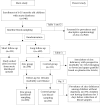Zinc deficiency: descriptive epidemiology and morbidity among preschool children in peri-urban population in Delhi, India
- PMID: 19902798
- PMCID: PMC2928091
- DOI: 10.3329/jhpn.v27i5.3639
Zinc deficiency: descriptive epidemiology and morbidity among preschool children in peri-urban population in Delhi, India
Abstract
Community-based data relating to factors influencing zinc deficiency among preschool children in India are inadequate. Data of a large, double-blinded, randomized, controlled zinc-supplementation trial were used for assessing the descriptive epidemiology of zinc deficiency among children aged 6-35 months (n = 940). In total, 609 children were followed up for 120 days for information on morbidity. Of these children, 116 from the control group belonging to the upper and the lower 25th quartile of plasma zinc status at baseline were selected for assessing the association of zinc deficiency with prospective morbidity. At baseline, demographic, socioeconomic and dietary information was collected, and anthropometric measurements and levels of plasma zinc were assessed. At baseline, 73.3% of the children were zinc-deficient (plasma zinc < 70 microg/dL), of which 33.8% had levels of plasma zinc below 60 microg/dL. A significantly higher risk of morbidity was prevalent among the subjects with lower plasma zinc compared to those with higher levels of plasma zinc.
Figures
References
-
- Black RE. Zinc deficiency, infectious disease and mortality in the developing world. J Nutr. 2003;133(Suppl 1):1485S–9S. - PubMed
-
- Bhandari N, Bahl R, Taneja S, Strand T, Mølbak K, Ulvik RJ, et al. Substantial reduction in severe diarrheal morbidity by daily zinc supplementation in young north Indian children. Pediatrics. 2002;109:e86. - PubMed
-
- Bhutta ZA, Black RE, Brown KH, Gardner JM, Gore S, Hidayat A, et al. Prevention of diarrhea and pneumonia by zinc supplementation in children in developing countries: pooled analysis of randomized controlled trials. Zinc Investigators’ Collaborative Group. J Pediatr. 1999;135:689–97. - PubMed
-
- Gibson RS. Zinc: a critical nutrient in growth and development. N Z Med J. 1998;111:63–4. - PubMed
-
- Sazawal S, Black RE, Menon VP, Dinghra P, Caulfield LE, Dhingra U, et al. Zinc supplementation in infants born small for gestational age reduces mortality: a prospective, randomized, controlled trial. Pediatrics. 2001;108:1280–6. - PubMed
Publication types
MeSH terms
Substances
LinkOut - more resources
Full Text Sources


